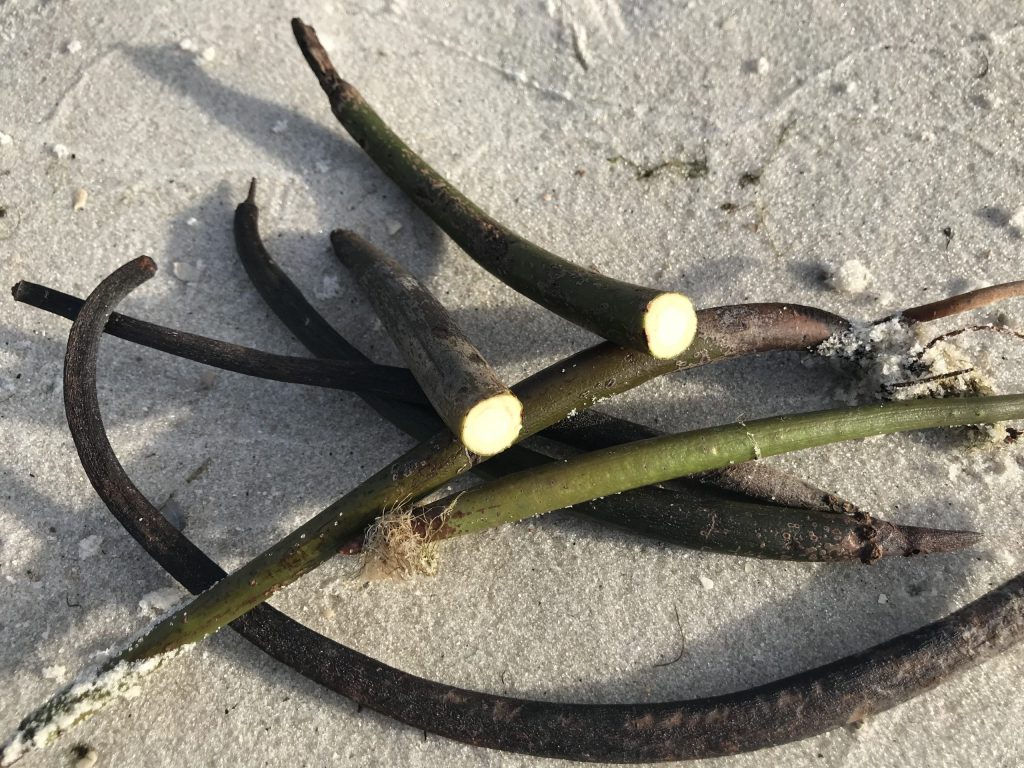
The cooked center of the Red Mangrove propagule is edible. Photo by Green Deane
Can you eat red mangroves? If you had nothing else to eat, yes. For many people Red Mangroves are just a shoreline obstruction. But they are an emergency food, a source of salt, tea, even cattle fodder. At one time, some 70 years ago, the leaves were dried, powdered, and sold as a supplement.
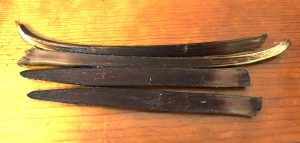
Red Mangroves propagules cooked.
If you are inclined to eat them boil the seed pods (they really aren’t seed pods but for convenience let’s call these propagules seed pods.) Many folks write that they are bitter. I have not found that to be so. To me they are mealy, slightly dry and tasteless, like sandy grits perhaps, best mixed with something with a lot of flavor. I boil the pods, cool, cut them in half, scrape out the starchy inside, then boil or soak them again. A tea can be made from the leaves but it is recommended it be served with milk to bind with the high amount of tannin. Indeed, the leaves were once considered as the base material for human protein supplementation. However the high tannin content, 11.68%, made that prohibitive (in the 1950s.) And you can get salt off the leaves. You can read more about the red mangrove here.
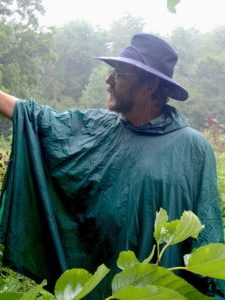
Classes are held rain or shine or cold. (Hurricanes are an exception.)
Foraging Classes: One official class this weekend, in West Palm Beach. There are always botanical surprises there and I need to find and take a picture of a Camachile tree.
Sunday, February 21st, Dreher Park, 1200 Southern Blvd., West Palm Beach, 33405, 9 .a.m. to noon. Meet just north of the science center.
Sunday February 28th, Bayshore Live Oak Park, Bayshore Drive. Port Charlotte. 9 a.m. to noon, meet in the parking lot at Ganyard and Bayshore.
Saturday, March 6th, Red Bug Slough Preserve, 5200 Beneva Road, Sarasota, FL, 34233. 9 a.m. to noon.
Sunday, March 7th, Mead Gardens, 1500 S. Denning Dr., Winter Park, FL 32789. 9 a.m. to noon. The entrance is on the west side off Denning not the east side off Pennsylvania. Some GPS maps are wrong. Meet near the bathrooms.
Sunday, March 13th, Wickham Park, 2500 Parkway Drive, Melbourne, FL 32935-2335. 9 a.m. to noon. Meet at the “dog park” inside the park.
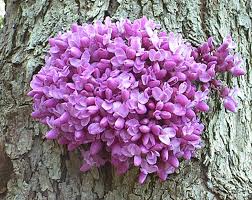
A bunch of Eastern Red Buds. Photo by Green Deane
We are finding quite a few seasonal forageables. In my classes we are seeing natal plum, swinecress and Latex Strangler Vine fruit, some of which was mentioned in recent newsletters. While we nibbled on many things among them were Turks Cap, Oxalis, Black Nightshade, Violets, False Hawk’s Beard, Plantagos, Fireweed, and Hairy Bittercress which is barely hairy at all. Also noticed during the forage was a tasty False Roselle not yet done in by the cool weather. And although the Eastern Red Bud won’t flower in profusion for couple of months we found a couple of cold-daring blossoms to look at.
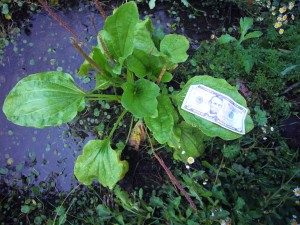
Plantago rugulii is a large local plantago. Photo by Green Deane
Plantago Power: It was a dark and rainy … morning… and I was searching through the gloom along the road for a wild mustard/radish for my foraging class. It was cold. It was rainy. It was gray. Something caught my eye so I pulled Van Go over and headed towards a watery ditch. Then I heard a baby cry. Seriously. The figure I thought was a bag lady with stuffed shopping cart was a bundled-up woman with a baby stroller waiting for a bus. Things look different in the dim drab of winter. And the plant I thought might be a mustard most certainly was not. It was a Plantago, the largest one I have ever seen. That was worth a picture and posting on the Green Deane Forum. There one of our regular members, Josey, who has an eye for detail and a whole lot of knowledge, offered it as Plantago Rugelii rather than P. major. One difference is the P. rugelii has purple at the base of the petiole, P. major is white. Unlike P.major, which is from Europe, P. rugelii is native to North America. It is odd that we don’t hear more about it. You can read about it here and watch a video here.
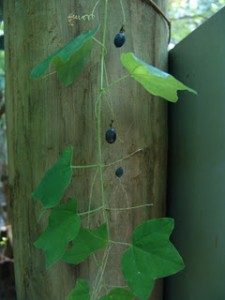
Edible but not too tasty.
There are several “edible” Passiflora locally but only a couple worth eating in my tender-tummy opinion: P. incarnata and P. foetida. They both have a tart-sweet flavor and the entire fruit is edible, seeds, pulp and skin. I have eaten both but not in huge quantities, usually one or two at a time. A couple that are marginal are P. lutea and P. suberosa. I see P. lutea often but not P. suberosa which tends to grow further north. During a foraging class this week in Largo we saw P. lutea. Off the vine the fruit is marginal. Maybe cooked into a jelly or a juice they might improve. I am a bit concerned that I have seen some websites say P. lutea leaves can be used medicinally like P. incarnata. I would question that though I am not an herbalist nor a chemist (they would not let me take chemistry in school.) But I seem to remember a study that tested numerous Passifloras and reported they all had some cyanide in their leaves except the P. incarnata which has GABA instead (gamma amino-butryc acid.) It was the only one, in the study at least, that did not have cyanide in its leaves and was specifically singled out. I would be careful about using any Passiflora leaves other than P. incarnata without thorough research first. Also avoid unripe fruit. One species, Passiflora adenopoda, from China, is definitely fatal. You can read about Passifloras here.
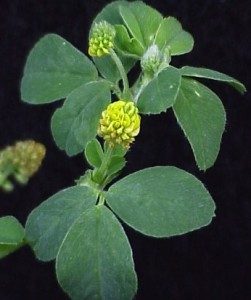
Black Medic
A fairly common “What is it?” seen now is Black Medic. It’s also an iffy edible. While the seeds and greens have been eaten it is not for everyone. Also, to the every-day forager it looks a lot like Hop Clover. Native to the area of Iran, it came to the east coast of the United States around 1807 and went west over the next 130 years. It was on the west coast of the United States in time for the Great Depression in the 1930’s. Native Americans were eating it when surveyed during the Depression thus it got listed as a Native American food. Before the species seeds the easiest way to identity Black Medic from Hop Clover is look at the center leaf of the trifolium. Black Medic’s central leaf has a longer stem than the other two leaves. In Hop Clover all three stems are the same length. Also when they seed Black Medic has black seeds, Hop Clover has brown seeds. And locally Black Medic is common whereas Hop Clover is found mostly Florida’s northwestern counties. You can read all about it here.

Green Deane videos are now available on a USB.
150-video USB or 135 video DVD set would be a good winter present and either is now $99. My nine-DVD set of 135 videos has been selling for seven years and are still available. They are the same videos I have on You Tube. Some people like to have a separate copy. A second option is a16-gig USB that has those 135 videos plus 15 more. While the videos can be run from the DVDs the videos on the USB have to be copied to your computer to play. They are MP4 files. The150-video USB is $99 and the 135-video DVD set is now $99. The DVDs will be sold until they run out then will be exclusively replaced by the USB. This is a change I’ve been trying to make for several years. So if you have been wanting the 135-video DVD set order it now as the price is reduced and the supply limited. Or you can order the USB. My headache is getting my WordPress Order page changed to reflect these changes. We’ve been working on it for several months. However, if you want to order now either the USB or the DVD set make a $99 “donation” using the link at the bottom of this page or here. That order form provides me with your address, the amount — $99 — tells me it is not a donation and in the note say if you want the DVD set or the USB.

Green Deane Forum
Want to identify a plant? Perhaps you’re looking for a foraging reference? You might have a UFO, an Unidentified Flowering Object, you want identified. On the Green Deane Forum we — including Green Deane and others from around the world — chat about foraging all year. And it’s not just about warm-weather plants or just North American flora. Many nations share common weeds so there’s a lot to talk. There’s also more than weeds. The reference section has information for foraging around the world. There are also articles on food preservation, and forgotten skills from making bows to fermenting food.
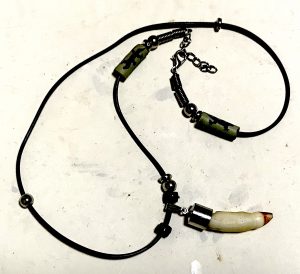
Alligator tooth pendant.
And two weeks ago in Port Charlotte we noticed after everyone had left an alligator tooth pendant on the picnic table. If it is yours let me know and I’ll get it back to you.
This is weekly newsletter #445, If you want to subscribe to this free newsletter you can find the sign-up form in the menu at the top of the page.
To donate to the Green Deane Newsletter click here.


I’m really confused whether today the weed I find here in Dawha’s (Qatar ) gardens could be Trifolium dubium , Hop clover or Black medic .A picture of it is sent to you .